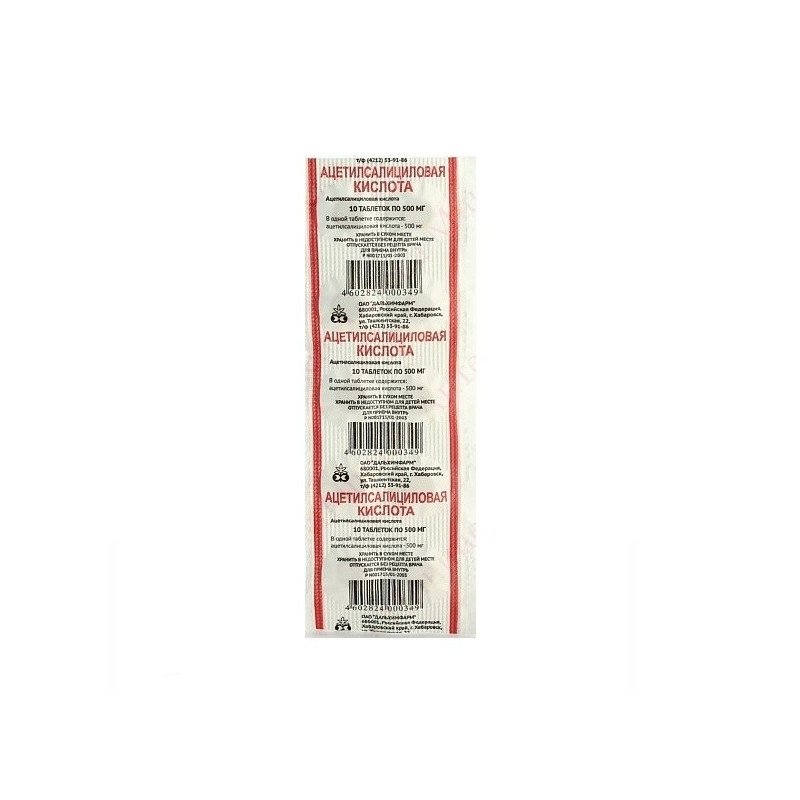



 All payments are encrypted via SSL
All payments are encrypted via SSL
 Full Refund if you haven't received your order
Full Refund if you haven't received your order
NSAIDs. It has anti-inflammatory, analgesic and antipyretic effects, as well as inhibits platelet aggregation. The mechanism of action is associated with inhibition of the activity of COX - the main enzyme in the metabolism of arachidonic acid, which is a precursor of prostaglandins, which play a major role in the pathogenesis of inflammation, pain and fever.
A pronounced analgesic effect of Acetylsalicylic acid is due to two mechanisms: peripheral (indirectly through suppression of prostaglandin synthesis) and central (due to inhibition of prostaglandin synthesis in the central and peripheral nervous systems. Due to reduced prostaglandin production, their effect on thermoregulation centers is reduced. Irreversible violation of synthesis in platelets2 causes antiplatelet effect of acetylsalicylic acid. When used in high doses, acetylsalicylic acid can inhibit the synthesis of prothrombin in the liver and increase the prothrombin time.
When ingestion is rapidly absorbed mainly in the proximal small intestine and to a lesser extent in the stomach.The presence of food in the stomach significantly alters the absorption of acetylsalicylic acid. Acetylsalicylic acid is distributed in most tissues and body fluids. Penetrates the BBB.
Metabolized in the liver by hydrolysis to form salicylic acid, followed by conjugation with Glycine or glucuronide. About 80% of salicylic acid binds to plasma proteins.
The half-life of acetylsalicylic acid is approximately 15 minutes, salicylic acid is about 3 hours. It is excreted by the kidneys mainly in the form of salicylic acid.
Rheumatism, rheumatoid arthritis, infectious-allergic myocarditis; fever in infectious and inflammatory diseases; pain syndrome of weak and medium intensity of various genesis (neuralgia, myalgia, headache); prevention of thrombosis and embolism; primary and secondary prevention of myocardial infarction; prevention of cerebral circulatory disorders of ischemic type.
Individual. For adults, a single dose varies from 150 mg to 2 g, daily - from 150 mg to 8 g; frequency of use - 2-6 times / day. For children older than 2 years, a single dose is 10-15 mg / kg, the frequency of use - up to 5 times / day.
Maximum doses: when taken for adults - 8 g, for children over 10 years old - 100 mg / kg.
Gastrointestinal: nausea, vomiting, anorexia, epigastric pain, diarrhea; rarely - the occurrence of erosive and ulcerative lesions, bleeding in the digestive tract, abnormal liver function.
From the side of the central nervous system: with prolonged use, dizziness, headache, reversible visual disturbances, and tinnitus are possible.
Hemic and lymphatic: rarely - thrombocytopenia, anemia.
From the blood coagulation system: rarely - hemorrhagic syndrome, prolonged bleeding time.
Urogenital: rarely - impaired renal function.
Allergic reactions: rarely - skin rash, angioedema, bronchospasm.
Erosive and ulcerative lesions of the gastrointestinal tract in the acute phase; "aspirin triad"; history of indications for urticaria, rhinitis, caused by taking acetylsalicylic acid and other NSAIDs; hemophilia, hemorrhagic diathesis, hypoprothrombinemia; vitamin deficiency; severe renal impairment; pregnancy (I and III trimester), hypersensitivity to acetylsalicylic acid and other salicylates.
Contraindicated for use in the I and III trimesters of pregnancy. In the II trimester of pregnancy a one-time admission is possible according to strict indications.
Acetylsalicylic acid is excreted in breast milk, which increases the risk of bleeding in a child due to dysfunction of platelets, therefore, with long-term use of acetylsalicylic acid during lactation, it is necessary to decide whether to stop breastfeeding.
It is used with caution in patients with diseases of the liver and kidneys, with bronchial asthma, erosive and ulcerative lesions and bleeding from the gastrointestinal tract in history, with increased bleeding or while conducting anticoagulant therapy. Acetylsalicylic acid even in small doses reduces the excretion of uric acid from the body, which can cause an acute attack of gout in susceptible patients. When conducting long-term therapy and / or the use of acetylsalicylic acid in high doses requires the supervision of a physician and regular monitoring of hemoglobin levels.
In children under 2 years old, it is used only for health reasons under strict medical supervision. Children and adolescents with diseases involving hyperthermia, acetosalicylic acid, it is desirable to use only with the ineffectiveness of other drugs. If prolonged vomiting is observed when using acetylsalicylic acid, this may be a sign of Reye's syndrome.
Acetylsalicylic acid in the form of pills is included in the List of Vital and Essential Drugs.
Acetylsalicylic acid enhances the action of other NSAIDs, Heparin, indirect anticoagulants, uricosuric drugs (probenecid, benzbromarone, sulfinpyrazon), diuretics, antihypertensive drugs, oral hypoglycemic agents, Methotrexate.Simultaneous administration with glucocorticoids increases the risk of erosive and ulcerative lesions of the gastrointestinal tract. Acetylsalicylic acid weakens the effect of diuretics, antihypertensive drugs, as well as anti-gout agents that promote the excretion of uric acid.
Acetylsalicylic acid increases the concentration of Digoxin, barbiturates and lithium salts in the blood plasma. With simultaneous use with antacids containing Magnesium and / or aluminum hydroxide, the absorption of acetylsalicylic acid slows down and deteriorates.
